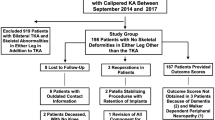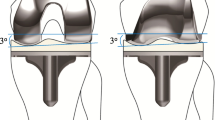Abstract
Purpose
Kinematic total knee arthroplasty (TKA) is an emerging technique, but concerns remain around the effect of implanting the prosthesis in more anatomic orientations. Native knees show variation in joint line orientation relative to the tibial mechanical axis but the joint line remains parallel to the floor when standing. This study was undertaken to evaluate joint line obliquity relative to the floor when weight-bearing after kinematic TKA to see if a similar effect occurs.
Methods
Preoperative and postoperative measurements were taken for 55 consecutive kinematically aligned TKAs, including the joint line orientation angle (JLOA), formed between the joint line and a line parallel to the floor.
Results
The mean medial proximal tibial angle (MPTA) was 3.4° varus pre-operatively (1.7° valgus to 7.9° varus, SD 2.0), and 3.0° varus postoperatively (5.5° valgus to 6.5° varus, SD 2.1). The mean postoperative JLOA was 1.0° varus with a smaller range than the MPTA (2.6° valgus to 6° varus, SD 1.9). The difference between these two measurements was significant (mean 2°, SD 2.5, p < 0.001).
Conclusions
Relative to the mechanical axis, 33 tibial components would be considered at risk outliers, being orientated at more than 3° in varus or valgus. However, only six components were outside this range relative to the vertical, all in varus (mean 4.2°). This latter measurement may better represent how the prosthesis is functionally loaded and is similar to mechanically aligned TKAs with good survivorship. This may help explain why kinematic alignment does not lead to higher earlier failure rates that may result if similar orientations were seen with mechanically aligned TKA.


Similar content being viewed by others
References
Rodricks DJ, Patil S, Pulido P, Colwell CW (2007) Press-fit condylar design total knee arthroplasty. Fourteen to seventeen-year follow-up. J Bone Joint Surg Am 89:89–95. doi:10.2106/JBJS.E.00492
Gill GS, Joshi AB, Mills DM (1999) Total condylar knee arthroplasty. 16- to 21-year results. Clin Orthop 367:210–215
Font-Rodriguez DE, Scuderi GR, Insall JN (1997) Survivorship of cemented total knee arthroplasty. Clin Orthop 345:79–86
Moreland JR, Bassett LW, Hanker GJ (1987) Radiographic analysis of the axial alignment of the lower extremity. J Bone Joint Surg Am 69:745–749
Hsu RW, Himeno S, Coventry MB, Chao EY (1990) Normal axial alignment of the lower extremity and load-bearing distribution at the knee. Clin Orthop 255:215–227
Victor JMK, Bassens D, Bellemans J et al (2014) Constitutional varus does not affect joint line orientation in the coronal plane. Clin Orthop 472:98–104. doi:10.1007/s11999-013-2898-6
Gu Y, Roth JD, Howell SM, Hull ML (2014) How frequently do four methods for mechanically aligning a total knee arthroplasty cause collateral ligament imbalance and change alignment from normal in white patients? AAOS Exhibit Selection. J Bone Joint Surg Am 96:e101. doi:10.2106/JBJS.M.00306
Baker PN, van der Meulen JH, Lewsey J, Gregg PJ (2007) The role of pain and function in determining patient satisfaction after total knee replacement. Data from the National Joint Registry for England and Wales. J Bone Joint Surg (Br) 89-B:893–900. doi:10.1302/0301-620X.89B7.19091
Bourne RB, Chesworth BM, Davis AM et al (2010) Patient satisfaction after total knee arthroplasty: who is satisfied and who is not? Clin Orthop 468:57–63. doi:10.1007/s11999-009-1119-9
Hollister AM, Jatana S, Singh AK et al (1993) The axes of rotation of the knee. Clin Orthop 290:259–268
Howell SM, Hull ML (2012) Kinematically aligned TKA with MRI-based cutting guides. In: Thienpont E (ed) Improving accuracy in knee arthroplasty. Jaypee Brothers Medical Publishers, New Delhi, pp 207–232
Bellemans J, Colyn W, Vandenneucker H, Victor J (2012) The Chitranjan Ranawat award: is neutral mechanical alignment normal for all patients? The concept of constitutional varus. Clin Orthop 470:45–53. doi:10.1007/s11999-011-1936-5
Howell SM, Papadopoulos S, Kuznik KT, Hull ML (2013) Accurate alignment and high function after kinematically aligned TKA performed with generic instruments. Knee Surg Sports Traumatol Arthrosc 21:2271–2280. doi:10.1007/s00167-013-2621-x
Howell SM, Howell SJ, Kuznik KT et al (2013) Does a kinematically aligned total knee arthroplasty restore function without failure regardless of alignment category? Clin Orthop 471:1000–1007. doi:10.1007/s11999-012-2613-z
Paley D (2002) Principles of deformity correction. Springer, Berlin
Cherian JJ, Kapadia BH, Banerjee S et al (2014) Mechanical, anatomical, and kinematic axis in TKA: concepts and practical applications. Curr Rev Musculoskelet Med 7:89–95. doi:10.1007/s12178-014-9218-y
Dossett HG, Swartz GJ, Estrada NA et al (2012) Kinematically versus mechanically aligned total knee arthroplasty. Orthopedics 35:e160–e169. doi:10.3928/01477447-20120123-04
Kastner N, Sternbauer S, Friesenbichler J et al (2013) Impact of the tibial slope on range of motion after low-contact-stress, mobile-bearing, total knee arthroplasty. Int Orthop 38:291–295. doi:10.1007/s00264-013-2242-5
Shi X, Shen B, Kang P et al (2013) The effect of posterior tibial slope on knee flexion in posterior-stabilized total knee arthroplasty. Knee Surg Sports Traumatol Arthrosc Off J ESSKA 21:2696–2703. doi:10.1007/s00167-012-2058-7
Werner FW, Ayers DC, Maletsky LP, Rullkoetter PJ (2005) The effect of valgus/varus malalignment on load distribution in total knee replacements. J Biomech 38:349–355. doi:10.1016/j.jbiomech.2004.02.024
Fang DM, Ritter MA, Davis KE (2009) Coronal alignment in total knee arthroplasty: just how important is it? J Arthroplasty 24:39–43. doi:10.1016/j.arth.2009.04.034
Ritter MA, Davis KE, Meding JB et al (2011) The effect of alignment and BMI on failure of total knee replacement. J Bone Joint Surg Am 93:1588–1596. doi:10.2106/JBJS.J.00772
Jeffery RS, Morris RW, Denham RA (1991) Coronal alignment after total knee replacement. J Bone Joint Surg (Br) 73:709–714
Pang H-N, Jamieson P, Teeter MG et al (2014) Retrieval analysis of posterior stabilized polyethylene tibial inserts and its clinical relevance. J Arthroplasty 29:365–368. doi:10.1016/j.arth.2013.05.029
Collier MB, Engh CA, McAuley JP, Engh GA (2007) Factors associated with the loss of thickness of polyethylene tibial bearings after knee arthroplasty. J Bone Joint Surg Am 89:1306–1314. doi:10.2106/JBJS.F.00667
Bonner TJ, Eardley WGP, Patterson P, Gregg PJ (2011) The effect of post-operative mechanical axis alignment on the survival of primary total knee replacements after a follow-up of 15 years. J Bone Joint Surg (Br) 93:1217–1222. doi:10.1302/0301-620X.93B9.26573
Parratte S, Pagnano MW, Trousdale RT, Berry DJ (2010) Effect of postoperative mechanical axis alignment on the fifteen-year survival of modern, cemented total knee replacements. J Bone Joint Surg Am 92:2143–2149. doi:10.2106/JBJS.I.01398
Morgan SS, Bonshahi A, Pradhan N et al (2008) The influence of postoperative coronal alignment on revision surgery in total knee arthroplasty. Int Orthop 32:639–642. doi:10.1007/s00264-007-0391-0
Dossett HG, Estrada NA, Swartz GJ et al (2014) A randomised controlled trial of kinematically and mechanically aligned total knee replacements: two-year clinical results. Bone Jt J 96-B:907–913. doi:10.1302/0301-620X.96B7.32812
Matsuzaki T, Matsumoto T, Muratsu H et al (2013) Kinematic factors affecting postoperative knee flexion after cruciate-retaining total knee arthroplasty. Int Orthop 37:803–808. doi:10.1007/s00264-013-1803-y
Digennaro V, Zambianchi F, Marcovigi A et al (2014) Design and kinematics in total knee arthroplasty. Int Orthop 38:227–233. doi:10.1007/s00264-013-2245-2
Author information
Authors and Affiliations
Corresponding author
Rights and permissions
About this article
Cite this article
Hutt, J., Massé, V., Lavigne, M. et al. Functional joint line obliquity after kinematic total knee arthroplasty. International Orthopaedics (SICOT) 40, 29–34 (2016). https://doi.org/10.1007/s00264-015-2733-7
Received:
Accepted:
Published:
Issue Date:
DOI: https://doi.org/10.1007/s00264-015-2733-7




